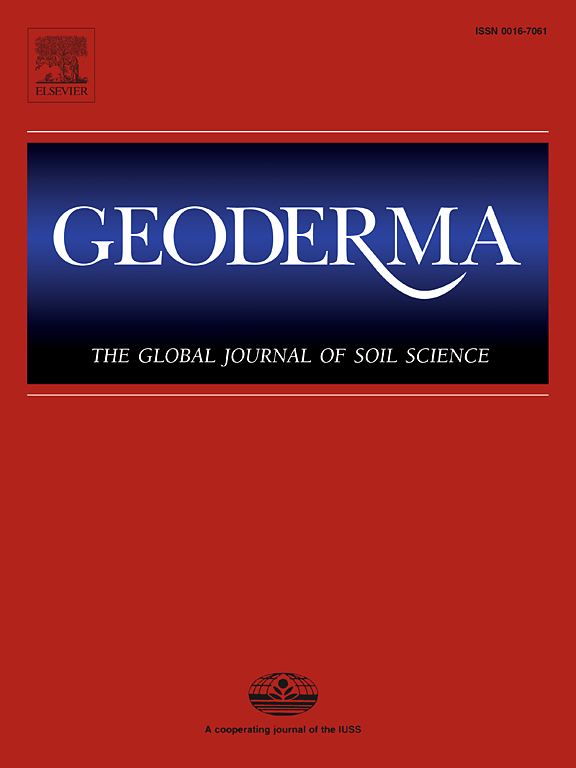Functional carbon pools and microbial communities in persistent carbon rich erosion buried topsoils
IF 5.6
1区 农林科学
Q1 SOIL SCIENCE
引用次数: 0
Abstract
Storing more C in subsoils can offset greenhouse gas emissions and C-rich buried horizons provide a unique opportunity to investigate the nature of subsurface C persistence. We identified five sites with varying soil texture across a climatic gradient that had C-rich buried surface horizons. We profiled the microbial community and characterized the soil organic matter of surface Ah, buried surface Ahb, and buried subsoil Bwb horizons to gain insight into these C-rich subsoils. Similar concentrations of C remained in Ahb horizons relative to Ah horizons, despite significant viable microbial biomass in Ahb horizons capable of decomposing the C at depth where little fresh C input has occurred in the decades since burial. The microbial community composition had shifted in Ahb horizons to be more similar to subsoil Bwb than surface Ah communities, indicating the SOC composition in Ahb horizons and conditions at depth strongly influenced their current status. Ahb horizons stored a greater proportion of C in mineral-associated organic matter (MAOM) than Ah horizons. Although similar microbial necromass quantity and concentration in Ah vs. Ahb soils, muramic acid was reduced in Ahb horizons, indicating significant recycling of microbial necromass. Commonalities in C-rich buried surface horizons between microbial and C profiles across a wide range of textures and climates, demonstrates that the general processes of C cycling and persistence are ubiquitous across buried surface horizons. These soils may provide an opportunity to examine microbial communities associated with persistent C that is difficult to isolate due to low concentration in surface soils.
持续富碳侵蚀埋地表层土壤功能碳库与微生物群落
在地下土壤中储存更多的碳可以抵消温室气体排放,而富含碳的地下层为研究地下碳持久性的性质提供了一个独特的机会。我们确定了五个具有不同土壤质地的地点,这些地点跨越了气候梯度,具有富含碳的地下层。通过微生物群落特征分析,对表层Ah层、埋藏表层Ahb层和埋藏底土Bwb层的土壤有机质进行了表征,以期深入了解这些富碳底土。尽管在埋藏后的几十年里新鲜碳输入很少的深度,Ahb层的活菌量能够分解C,但相对于Ah层,Ahb层的C浓度仍然相似。浅层土壤微生物群落组成变化趋势与底土微生物群落结构相似,与表层微生物群落结构相似,说明浅层土壤有机碳组成和深度条件对其现状影响较大。Ahb层比Ahb层在矿物伴生有机质(MAOM)中储存了更大比例的C。虽然Ahb和Ahb土壤中微生物坏死块的数量和浓度相似,但Ahb土壤中菌酸减少,表明微生物坏死块有明显的再循环作用。不同质地和气候条件下,富碳埋层微生物和碳剖面的共性表明,碳循环和持续的一般过程在埋层中普遍存在。这些土壤可能提供了一个机会来检查与持久性C有关的微生物群落,由于表层土壤浓度低而难以分离。
本文章由计算机程序翻译,如有差异,请以英文原文为准。
求助全文
约1分钟内获得全文
求助全文
来源期刊

Geoderma
农林科学-土壤科学
CiteScore
11.80
自引率
6.60%
发文量
597
审稿时长
58 days
期刊介绍:
Geoderma - the global journal of soil science - welcomes authors, readers and soil research from all parts of the world, encourages worldwide soil studies, and embraces all aspects of soil science and its associated pedagogy. The journal particularly welcomes interdisciplinary work focusing on dynamic soil processes and functions across space and time.
 求助内容:
求助内容: 应助结果提醒方式:
应助结果提醒方式:


